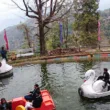Located in southwestern Arizona, the Kofa National Wildlife Refuge is a breathtakingly beautiful place that offers a unique glimpse into the natural wonders of the American Southwest. Encompassing over 665,400 acres of pristine desert landscape, the refuge is a haven for a wide variety of wildlife species, including bighorn sheep, desert tortoises, and a diverse array of birds.
In this article, we’ll take a closer look at the Kofa Wildlife Refuge, including its history, ecology, and the many outdoor recreational opportunities it offers visitors. Whether you’re an avid hiker, wildlife enthusiast, or simply someone who appreciates the beauty of nature, Kofa has something to offer you.
History and Geography of the Kofa National Wildlife Refuge
The Kofa National Wildlife Refuge was established in 1939, with the goal of providing a protected habitat for the desert bighorn sheep. At the time, the bighorn sheep population was in serious decline due to overhunting, habitat loss, and disease. The refuge was named after the King of Arizona gold mine, which was located within its borders.
Today, the Kofa Wildlife Refuge is home to over 500 bighorn sheep, making it one of the most important habitats for these animals in the United States. In addition to the bighorn sheep, the refuge is also home to a wide variety of other wildlife species, including coyotes, bobcats, mountain lions, and a diverse array of bird species.
The Kofa Wildlife Refuge is located in the Sonoran Desert, one of the most biologically diverse deserts in the world. The Sonoran Desert covers an area of approximately 100,000 square miles and stretches from southern Arizona into California and Mexico. The landscape of the Sonoran Desert is characterized by rugged mountains, rocky canyons, and vast expanses of cactus and other desert vegetation.
Exploring the Ecology of the Kofa National Wildlife Refuge
The Kofa Wildlife Refuge is home to a unique ecosystem that has evolved to thrive in the harsh conditions of the Sonoran Desert. The refuge is dominated by a variety of cactus species, including the iconic saguaro cactus, which can grow up to 50 feet tall and live for over 200 years.
Other common cactus species in the refuge include the barrel cactus, cholla cactus, and prickly pear cactus. These cacti provide important habitat and food sources for a wide variety of wildlife species, including desert bighorn sheep, which feed on the fruit of the saguaro cactus.
The refuge is also home to a variety of other desert plant species, including creosote bushes, palo verde trees, and ocotillo plants. These plants have adapted to survive in the hot, arid conditions of the Sonoran Desert by conserving water and minimizing their exposure to the sun.
The wildlife species that call the Kofa Wildlife Refuge home are just as diverse as the plants. In addition to the bighorn sheep, the refuge is home to a variety of other mammals, including coyotes, bobcats, mountain lions, and gray foxes.
Bird enthusiasts will also find plenty to see in the refuge, with over 300 species of birds having been spotted within its borders. Some of the most commonly sighted bird species in the refuge include the Gambel’s quail, Gila woodpecker, and cactus wren.
Outdoor Recreation Opportunities at the Kofa National Wildlife Refuge
The Kofa Wildlife Refuge offers a wide variety of outdoor recreational opportunities for visitors. Whether you’re an avid hiker, photographer, or wildlife enthusiast, there is something for everyone to enjoy in this beautiful natural area.
One of the most popular activities in the Kofa National Wildlife Refuge is hiking. The refuge is home to a variety of hiking trails that offer stunning views of the desert landscape and the surrounding mountains. One of the most popular trails in the refuge is the Palm Canyon Trail, which takes hikers through a narrow canyon filled with palm trees and offers the opportunity to spot bighorn sheep.
Another popular activity in the refuge is wildlife viewing. Visitors can observe a variety of wildlife species in their natural habitat, including bighorn sheep, coyotes, and a variety of bird species. The refuge offers several wildlife viewing areas, including the Kofa Queen Canyon Viewing Area and the Crystal Hill Viewing Area.
For those who enjoy camping, the Kofa National Wildlife Refuge offers several rudimentary camping areas where visitors can enjoy the beauty of the desert night sky. Visitors can camp at designated sites throughout the refuge but are advised to bring their own water and supplies as there are no amenities available.
Finally, the Kofa National Wildlife Refuge also offers hunting opportunities for those with proper permits. The refuge is home to a variety of game species, including bighorn sheep, quail, and mule deer.
Conservation Efforts in the Kofa National Wildlife Refuge
The Kofa National Wildlife Refuge is committed to conserving the natural resources of the Sonoran Desert and protecting the wildlife species that call it home. The refuge works closely with local and state agencies, as well as nonprofit organizations, to monitor wildlife populations and ensure that their habitats are protected.
One of the primary conservation efforts in the refuge is the management of the bighorn sheep population. The refuge conducts surveys to monitor the health of the bighorn sheep population and works to maintain and improve their habitat through vegetation management and water development projects.
In addition to the bighorn sheep, the Kofa National Wildlife Refuge also works to protect and conserve other wildlife species in the area, including the desert tortoise and the Sonoran pronghorn. The refuge also works to manage invasive species and prevent habitat destruction from human activities such as off-road vehicle use and littering.
Conclusion
The Kofa National Wildlife Refuge is a stunningly beautiful area that offers visitors a unique glimpse into the natural wonders of the Sonoran Desert. From the towering saguaro cacti to the elusive bighorn sheep, there is something for everyone to enjoy in this beautiful natural area.
Whether you’re an avid hiker, wildlife enthusiast, or simply someone who appreciates the beauty of nature, the Kofa National Wildlife Refuge is a must-see destination. With its diverse array of plant and animal species, breathtaking views, and variety of outdoor recreational opportunities, the refuge is a true gem of the American Southwest. So pack your hiking boots and camera, and get ready to discover the natural wonders of the Kofa National Wildlife Refuge.
Similar Articles
Frequently Asked Questions About Kofa National Wildlife Refuge
Q: What is the Kofa National Wildlife Refuge?
A: The Kofa Wildlife Refuge is a protected area of land in Arizona, USA, managed by the United States Fish and Wildlife Service. The refuge encompasses over 660,000 acres of the desert landscape and is home to a variety of wildlife species, including bighorn sheep, coyotes, and a variety of bird species.
Q: What is the history of the Kofa Wildlife Refuge?
A: The Kofa Wildlife Refuge was established in 1939 to protect the desert bighorn sheep population in the area. The refuge was named after the King of Arizona Mine, which was located in the area during the late 1800s and early 1900s. Today, the Kofa Wildlife Refuge is managed by the United States Fish and Wildlife Service and is open to visitors for outdoor recreation and wildlife viewing.
Q: What kind of wildlife can be found in the Kofa Wildlife Refuge?
A: The Kofa Wildlife Refuge is home to a diverse array of wildlife species, including bighorn sheep, coyotes, desert tortoises, and a variety of bird species such as cactus wrens and Gambel’s quail.
Q: What kind of recreational opportunities are available in the Kofa Wildlife Refuge?
A: The Kofa Wildlife Refuge offers a variety of outdoor recreational opportunities, including hiking, wildlife viewing, camping, and hunting (with proper permits).
Q: What are some popular hiking trails in the Kofa Wildlife Refuge?
A: The Palm Canyon Trail is one of the most popular hiking trails in the Kofa Wildlife Refuge. This trail takes hikers through a narrow canyon filled with palm trees and offers stunning views of the surrounding desert landscape. Other popular hiking trails in the refuge include the Signal Peak Trail and the Kofa Queen Canyon Trail.
Q: What is the best time of year to visit the Kofa Wildlife Refuge?
A: The best time to visit the Kofa Wildlife Refuge is during the cooler months of the year, typically from November to March. Temperatures during the summer months can reach over 100 degrees Fahrenheit, making outdoor activities uncomfortable and potentially dangerous.
Q: Are there any camping facilities in the Kofa Wildlife Refuge?
A: The Kofa Wildlife Refuge offers several rudimentary camping areas where visitors can enjoy the beauty of the desert night sky. Visitors can camp at designated sites throughout the refuge but are advised to bring their own water and supplies as there are no amenities available.
Q: Is hunting allowed in the Kofa Wildlife Refuge?
A: Hunting is allowed in the Kofa Wildlife Refuge with proper permits. The refuge is home to a variety of game species, including bighorn sheep, quail, and mule deer.
Q: How is the Kofa Wildlife Refuge working to conserve the natural resources of the Sonoran Desert?
A: The Kofa Wildlife Refuge is committed to conserving the natural resources of the Sonoran Desert and protecting the wildlife species that call it home. The refuge works closely with local and state agencies, as well as nonprofit organizations, to monitor wildlife populations and ensure that their habitats are protected. One of the primary conservation efforts in the refuge is the management of the bighorn sheep population, which includes surveys and vegetation management, and water development projects.
Q: Are there any fees to visit the Kofa Wildlife Refuge?
A: There are no entrance fees to visit the Kofa National Wildlife Refuge. However, some activities, such as camping and hunting, may require permits and associated fees.
Q: Can visitors bring pets to the Kofa Wildlife Refuge?
A: Pets are allowed in the Kofa Wildlife Refuge, but they must be kept on a leash at all times. Visitors should also be aware that the desert environment can be dangerous for pets, as there may be venomous snakes and other wildlife in the area.
Q: Is there a visitor center at the Kofa Wildlife Refuge?
A: There is no visitor center at the Kofa National Wildlife Refuge. However, visitors can obtain maps and information at the refuge headquarters or the various trailheads throughout the refuge.
Q: Are there any guided tours or educational programs available at the Kofa National Wildlife Refuge?
A: The Kofa National Wildlife Refuge does not offer guided tours or educational programs on a regular basis. However, the refuge does occasionally offer special events and educational programs, such as birdwatching tours and nature hikes.
Q: Can visitors go off-trail in the Kofa National Wildlife Refuge?
A: Visitors are advised to stay on designated trails in the Kofa National Wildlife Refuge to protect the delicate desert ecosystem and avoid damaging wildlife habitats.
Q: Are there any safety precautions visitors should take when visiting the Kofa National Wildlife Refuge?
A: Visitors should be aware of the potentially dangerous wildlife in the area, such as venomous snakes and other predators. They should also bring plenty of water and be prepared for the hot desert environment, especially during the summer months. Visitors should also practice Leave No Trace principles and pack out all trash and waste.
Q: How can visitors help support the conservation efforts at the Kofa National Wildlife Refuge?
A: Visitors can help support the conservation efforts at the Kofa National Wildlife Refuge by practicing Leave No Trace principles, respecting wildlife and their habitats, and reporting any suspicious or illegal activity to the refuge staff. They can also consider making a donation to support the refuge’s conservation efforts.









